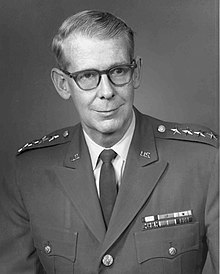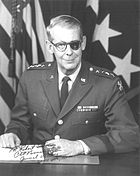Charles H. Bonesteel III
Charles H. Bonesteel III | |
|---|---|
 | |
| Birth name | Charles Hartwell Bonesteel III |
| Nickname(s) | "Tick" |
| Born | September 26, 1909 Plattsburgh, New York, U.S. |
| Died | October 13, 1977 (aged 68) Alexandria, Virginia, U.S. |
| Buried | |
| Allegiance | |
| Service | |
| Years of service | 1931–1969 |
| Rank | |
| Commands | 24th Infantry Division VII Corps Eighth United States Army United States Forces Korea United Nations Command Korea (CINC USFK/UNC) |
| Battles / wars | World War II Korean War Vietnam War |
| Awards | Distinguished Service Medal (2) Legion of Merit (2) |
| Relations | Major General Charles Hartwell Bonesteel Jr. (father) |
Charles Hartwell Bonesteel III (September 26, 1909 – October 13, 1977) was an American military commander, the son of Major General Charles Hartwell Bonesteel Jr. and grandson of Major Charles H. Bonesteel Sr. (1851–1902). He served in the United States Army during World War II, the Korean War and the Vietnam War. In the 1960s, he served for a time as commander United States Forces Korea during the Korean DMZ Conflict (1966–69).
Early life and education
Bonesteel was born on September 26, 1909 in Plattsburgh, New York.[1] As a teenager, he was an Eagle Scout and was awarded the Distinguished Eagle Scout Award by the Boy Scouts of America.[2]
Career
A 1931 graduate of the United States Military Academy at West Point, Bonesteel received from his classmates the lifelong nickname of "Tick." After graduation, he was a Rhodes Scholar at the University of Oxford.[4][5]
After carrying out a series of command and staff assignments, he served in the United States and Europe during World War II in a number of senior positions. With the surrender of Japan imminent, Bonesteel, General George A. Lincoln, and Colonel Dean Rusk of the Strategy Policy Committee at the Pentagon were tasked with drawing up General Order No. 1 to define the areas of responsibility for American, Soviet and Chinese forces. On August 10, 1945 with Soviet forces already moving through Manchuria into northern Korea, Bonesteel proposed the 38th parallel as the Division of Korea. The draft General Order was cabled to the Soviets on 15 August and accepted by them the following day.[6]
In the postwar era, Bonesteel served as special assistant to the Secretary of State. In November 1958, in an official capacity, he visited the city of Saigon, Republic of Vietnam (South Vietnam). He also served as commanding general of the 24th Infantry Division (1961–1962), and commanding general of the VII Corps (1962–1963).
Bonesteel served as the Commander of U.S. Forces Korea (and Commander-in-Chief, U.N. Command Korea; Commanding General, Eighth U.S. Army) from 1966 to 1969. During this period he defended against North Korean infiltration during the Korean DMZ Conflict (1966-1969) and dealt with tensions arising from the January 1968 Pueblo Incident.
Later life and death
Bonesteel retired from the U.S. Army in 1969, died on October 13, 1977 and is buried in Arlington National Cemetery near his father and grandfather.
Awards and decorations
- Distinguished Service Medal, twice (General Staff War Department, 1944–45; retirement, 1969)[7]
- Legion of Merit, twice (Sicily, 1943; European Theater, 1943–44)[7]
- Honorary Officer of the Order of the British Empire (United Kingdom)[7]
- Croix de Guerre (France)[7]
References
- ^ Kinfolk. Vol. 29–33. Wellfleet, MA: Rich Family Association. 1994. p. 3.
- ^ "Distinguished Eagle Scouts" (PDF). Scouting.org. Retrieved 2010-11-04.
- ^ Dane Publishing Company, Scenes from an Unfinished War: Low Intensity Conflict in Korea 1966–1969, 1991, page 10
- ^ St. Petersburg Times, Charles Bonesteel, Retired General, October 15, 1977
- ^ Lewis Sorley, editor, Vietnam Chronicles: The Abrams Tapes, 1968–1972, 2004, page 245
- ^ Chong-sik Lee (December 1985). "Why did Stalin accept the 38th Parallel?". Asia International Quarterly. doi:10.1007/BF03025069.
{{cite journal}}: Cite journal requires|journal=(help) - ^ a b c d Houterman, Hans. "US Army Officers 1939–1945: Bonesteel 3d, Charles Hartwell". World War II unit histories. Retrieved 11 February 2014.
External links
- 1909 births
- 1977 deaths
- American Rhodes Scholars
- American army personnel of World War II
- American army personnel of the Korean War
- American army personnel of the Vietnam War
- Burials at Arlington National Cemetery
- Military personnel from New York City
- Recipients of the Distinguished Service Medal (United States)
- Recipients of the Legion of Merit
- Honorary Officers of the Order of the British Empire
- Recipients of the Croix de Guerre 1939–1945 (France)
- United States Military Academy alumni
- United States Army generals
- Distinguished Eagle Scouts


